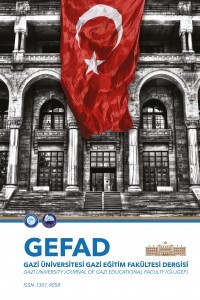Atomun Yapısının Kavratılmasında ve Yanlış Kavramaların Giderilmesinde Bütünleştirici ve Geleneksel Öğretim Yöntemlerinin Etkileri
Araştırmanın amacı, “Atomun Yapısı” konusunun kavratılmasında; “Geleneksel Anlatım Yöntemi” ile “Bütünleştirici (constructivist) Yöntem” in başarıya etkilerini karşılaştırmaktır. Çalışma Kırklareli-Babaeski Lisesi I. Sınıf öğrencileri ile gerçekleştirilmiştir. Öğrencilere “ön test” uygulayarak ön bilgileri ve yanlış kavramları tespit edilmiştir. Başarı bakımından denk iki grup oluşturularak, biri “kontrol grubu” diğeri “deney grubu“ olarak belirlenmiştir. Kontrol grubuna geleneksel anlatım yöntemi, deney grubuna bütünleştirici yöntemle öğretim yapılmıştır. Öğrencilere öğretimden önce Atomun yapısı Ön Bilgi Testi, Mantıksal Düşünme Yetenek Testi, Bilimsel İşlem Beceri Testi ve Atomun Yapısı Kavram Testi-İlk olarak uygulanmıştır. Uygulamadan sonra başarıyı belirlemek amacıyla AtoThe purpose of this study is to compare the “traditional teaching technique” and “constructivist approach” as regards to the perception of the concepts related to the “structure of atom“. The study was carried out with the 9th year students in Kırklareli Babaeski High school. The students have been given a pre-test in order to determine their primary knowledge and misconceptions. Two groups have been formed with equal success rates. One of them is determined as the “control” and the other as the “experimental” group. Control and the experimental groups were taught with traditional and constructivist approach respectively. All the students were given a Prior Knowledge Test related to Structure of Atom, Logical Thinking Skill Test, Scientific Calculation Skill test and Atomic Structure Concepts test before the teaching process. In order to evaluate their success, after the teaching process, Atomun yapısı, bütünleştirici yöntem, kavram yanılgıları.Structure of atom, Constructivist Method, Misconceptions. Tam Metin
Anahtar Kelimeler:
Atomun yapısı, bütünleştirici yöntem, kavram yanılgıları.
Effects of the Traditional Method and Constructivist Approach on the Understanding of Atomic Structure and Elimination of Related Misconceptions
The purpose of this study is to compare the “traditional teaching technique” and “constructivist approach” as regards to the perception of the concepts related to the “structure of atom“. The study was carried out with the 9th year students in Kırklareli Babaeski High school. The students have been given a pre-test in order to determine their primary knowledge and misconceptions. Two groups have been formed with equal success rates. One of them is determined as the “control” and the other as the “experimental” group. Control and the experimental groups were taught with traditional and constructivist approach respectively. All the students were given a Prior Knowledge Test related to Structure of Atom, Logical Thinking Skill Test, Scientific Calculation Skill test and Atomic Structure Concepts test before the teaching process. In order to evaluate their success, after the teaching process, Atomun yapısı, bütünleştirici yöntem, kavram yanılgıları.Structure of atom, Constructivist Method, Misconceptions. Tam Metin
Keywords:
Structure of atom, Constructivist Method, Misconceptions.,
___
- Ben-Zwi, R.I., Eylan, B & Sılberstein J. (1986). “Is an Atom of Copper Malleable?” Journal of Chemical Education, 63 (1) 64-66.
- Bodner, M.C (1986a). Constructivism: A Theory of Knowledge. Journal of Chemical Education, 63 (10), 873-878 and (1986b), 71 (3), 184-190.
- Bodner, G.M.,Klobuchar, M. & Geelan, D.,(2001). The Many Form of Constructivism. Journal of Chemical Education, 78(8), 1107.
- Chandran, S., Treagust, D., and Tobin, K. (1987). The Role of Cognitive Factors in Chemistry Achievement. Journal of Research in Science Teaching, 24, 145- 160
- Colburn, A. (2000). Constructivism: Science Education’s” Grand Unifying Theory”. The Clearance House, 74(1), 9-12.
- Burns J.C, Okey J.R, & wise K.C (1985). Development of and Integrated Process Skill Test: TipsII. Journal of Research in Science Teaching, 22 (2), 169-177[12]
- Gabel, D.L., Samuel, K.V & Hunn, D.J.(1987). Understanding the Particulate Nature of Matter. Journal of Chemical Education, 64, 695- 697.
- Griffıtths, A. K & Preston, K. P (1992). Grade–12 Students Misconceptions Relating to Fundamental Characteristic of Atoms and Molecules. Research in Science Teaching, 29(6), 611-628.
- Harrison, A.G. & Treaqust, D.F. (1996). Secondary Students Mental Models of Atoms and Molecules: İmplications for Teaching Chemistry. Science Education, 80(5), 509-534,
- Novick, S. & Nussbaum, J. (1981). “Pupils’ Understanding of the Particulate Nature of Matter: A Cross-age Study”. Science Education, 65 (2), 187-196.
- Onwuegbuzie, A.J. (2000). Science Process Skill and Achievement in Research Methodology Courses, Bowling Green: Annual Meeting of the Mid-South Educational Research Association
- Rosenshine, B. (1987). Explicit Teaching, D. Berliner and B. Rosenshine (Eds.) Talks to Teachers, New York: Rondam House.
- Senemoğlu, N. (1998). Gelişim, Öğrenme ve Öğretim: Gazi Kitapevi, Ankara.
- Stuessy, C. (1984). Correlates of Scientific Reasoning in Adolescents: Experience, Locus of Control, Age, Field, Dependence-Independence, Rigidity/Flexibility, IQ and Gender. Doctoral Dissertation, Columbus, Ohio: The Ohio State University
- Sutan A. & McHugh A. (1994). Atoms Family. Science Scope, 18 (2), 22-26.
- Taber, K.S. (2002). Conceptualizing Quanta–Illuminating the Ground State of Student Education: Research and Practice in Europe, 3(2), 145-158
- Tobin K. & Copie W. (1981). The Development and Validation of a Group Test of Logical Thinking. Educational an Psychological Measurement, 41 (2), 413- 423.
- Tsaparlis, G. (1997). Atomic and Molecular Structure in Chemical Education. Journal of Chemical Education, 74 (8), 922-925.
- White, R. T. (1993). Learning Science. Oxford: Blackwell Publishers.
- White, R. & Gunstone, R. (1992). Probing Understandin. London, The Falmer Press.
- Yager, R.E (1991). The Constructivist Learning Model. Science Teacher, 58 (6), 52-57.
- ISSN: 1301-9058
- Yayın Aralığı: Yılda 3 Sayı
- Başlangıç: 1985
- Yayıncı: Gazi Üniversitesi
Sayıdaki Diğer Makaleler
Oluşturmacı Yaklaşıma Göre Tasarlanan Öğrenme Ortamının Matematik Başarısına Etkisi
Örgütsel Vatandaşlık Davranışları: Kavramsal Bir Çözümleme ve Okul Açısından Bazı Çıkarımlar
İlköğretim 6. Sınıf Öğrencilerinin Dünya ve Evren Konusu İle İlgili Kavram Yanılgıları
Herzberg in Çift Faktörlü Güdüleme Kuramının Öğretmenlerin Motivasyonu Açısından Çözümlenmesi
